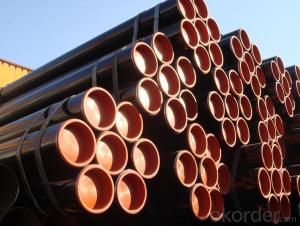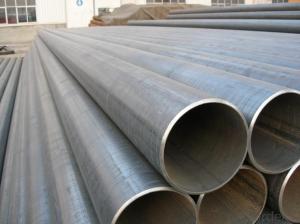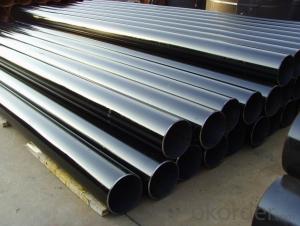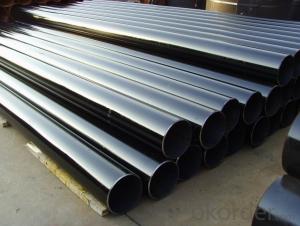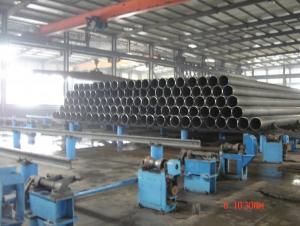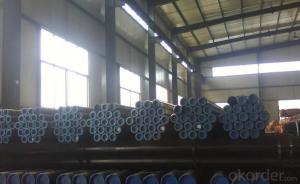high quality api 5ct erw steel pipe
- Loading Port:
- China Main Port
- Payment Terms:
- TT OR LC
- Min Order Qty:
- -
- Supply Capability:
- -
OKorder Service Pledge
OKorder Financial Service
You Might Also Like
WELDED ROUND STEEL PIPE
Commodity | Steel Pipe and Tube | ||
Features |
OD(mm) |
Thickness(mm) |
Length(m) |
Cross-sectional | |||
Round: | 21.3-273.1 | 1.0-9.5 | 5.8/6 or you require |
Square: | 15*15-300*300 | 1.0-15.0 | 5.8/6 or you require |
Rectangular: | 10*15-350*400 | 1.0-15.0 | 5.8/6 or you require |
National Standard | |||
Welded Steel Pipe For Transportation Of Low Pressure Fluid | |||
GB/T13091-2001 | |||
1 | Outside Diameter Of Steel Pipe | ||
Outside Diameter D/mmm | Tolerance Of Pipe Outside Diameter | Tolerance Of Pipe And Outside Diameter/mm | |
D≤48.3 | ±0.5mm |
| |
48.3<D≤508 | ±1.0% |
| |
168.3<D≤508 | ±0.75% | +2.4 -0.8 | |
D>508 | ±1.0% | +3.0 -0.8 | |
Tolerance Of Wall Thickness | ±12.5% | ||
2 | Length | Usual Length | Tolerance |
4M-9M | +20 -0 | ||
Multiple Length:5-10mm Tolerance For Each Mutiple | +20 -0 | ||
3 | Bending | ≤168.3mm | Straight For Ordinary Use Or Negotiate The Bending |
>68.3mm | Smaller Than 0.2%Of Full Length Steel Pipe | ||
Nominal Pipe size (inch) | Outside Diameter (mm) | Schedule 1 | ||
Nominal Wall Thickness (mm) | Weight(kg/m) | |||
Small |
Big
| |||
1/2” | 20 | 1.0-2.75 | 0.467 | 1.168 |
3/4” | 25 | 0.9-2.75 | 0.662 | 1.55 |
1” | 32 | 1.0-3.25 | 0.693 | 2.341 |
11/4 | 40 | 1.0-3.25 | 1.24 | 2.945 |
11/2 | 47 | 1.0-3.5 | 1.367 | 3.5 |
2 | 59 | 1.5-3.5 | 3.758 | 4.716 |
21/2 | 75 | 1.5-3.75 | 2.718 | 6.588 |
3 | 88 | 1.8-3.75 | 3.825 | 7.79 |
4 | 114 | 1.5-4.0 | 4.16 | 10.85 |
5 | 140 | 2.5-4.25 | 8.476 | 14.227 |
6 | 165 | 2.5-4.5 | 10.017 | 17.717 |
8 | 219 | 3.5-5.0 | 18.572 | 26.385 |
- Q: How are steel pipes used in water transportation?
- Steel pipes are commonly used in water transportation due to their durability and strength. They can be used for various purposes, such as carrying water from a source to a treatment plant, distributing water to different areas, and even for sewage systems. Steel pipes are highly resistant to corrosion and can withstand high pressure, making them ideal for long-distance water transportation.
- Q: What is the impact of temperature on steel pipes?
- The impact of temperature on steel pipes is significant and can have both positive and negative effects. At high temperatures, steel pipes can experience thermal expansion, causing them to expand and potentially leading to distortion or buckling. This expansion can also affect the joints and connections, potentially causing leaks or failures. Therefore, it is crucial to consider the coefficient of thermal expansion when designing and installing steel pipes in high-temperature environments. On the other hand, steel pipes typically have excellent thermal conductivity, allowing them to withstand high temperatures without significant degradation. This makes them suitable for applications where heat transfer is a primary concern, such as in industrial processes or heating systems. Extreme cold temperatures can have detrimental effects on steel pipes as well. In freezing conditions, water or other fluids inside the pipes can expand and lead to cracks or bursts. This can cause leaks, loss of fluid, and potential damage to surrounding structures. Therefore, appropriate insulation and preventive measures need to be taken to ensure the integrity of steel pipes in cold environments. Additionally, temperature variations can also affect the mechanical properties of steel, such as its tensile strength and toughness. For instance, exposure to elevated temperatures over an extended period can lead to a phenomenon known as thermal degradation, where the steel's strength decreases, making it more prone to deformation or failure. In conclusion, the impact of temperature on steel pipes is significant and can influence their structural integrity, thermal performance, and mechanical properties. Proper design, insulation, and maintenance are essential to ensure the safe and efficient operation of steel pipes in various temperature conditions.
- Q: Can steel pipes be used for transporting slurry?
- Yes, steel pipes can be used for transporting slurry. Steel pipes are commonly used in various industries, including mining, construction, and oil and gas, for transporting different types of fluids, including slurry. Slurry is a mixture of solid particles suspended in a liquid, usually water, and steel pipes have the required strength and durability to handle the abrasive nature of slurry. Additionally, steel pipes have excellent resistance to corrosion, which is crucial when dealing with slurry that may contain corrosive elements. The smooth inner surface of steel pipes also helps to minimize friction and ensure efficient flow of the slurry. Overall, steel pipes are a reliable and commonly used choice for transporting slurry due to their strength, durability, corrosion resistance, and smooth inner surface.
- Q: What is galvanized steel pipe?
- Galvanized steel pipe is a type of steel pipe that has been coated with a layer of zinc, which helps protect it from corrosion and rust. This coating also increases the pipe's longevity and makes it suitable for various applications, including plumbing, construction, and outdoor structures.
- Q: What are the advantages of using steel pipes in plumbing systems?
- There are several advantages of using steel pipes in plumbing systems. Firstly, steel pipes are highly durable and can withstand high levels of pressure, making them suitable for carrying water and other fluids. Additionally, steel pipes are resistant to corrosion, which ensures longevity and prevents leaks. Steel pipes also have a smooth interior surface, which improves water flow and reduces the risk of blockages. Moreover, steel pipes are fire-resistant and do not contribute to the spread of flames, enhancing overall safety. Lastly, steel pipes are environmentally friendly as they are often made from recycled materials and can be recycled again at the end of their lifespan.
- Q: What is the maximum pressure that steel pipes can handle?
- The maximum pressure that steel pipes can handle depends on various factors such as the grade and thickness of the steel, the diameter of the pipe, and the intended application. However, steel pipes are known for their high strength and durability, allowing them to withstand high pressure conditions. In general, steel pipes can handle pressures ranging from a few hundred PSI (pounds per square inch) to several thousand PSI, depending on the specific specifications and design considerations. It is crucial to consult engineering standards, industry guidelines, and relevant experts to determine the appropriate maximum pressure for a specific steel pipe.
- Q: 20# seamless steel pipe and seamless steel pipe 20G what is the difference?
- 20G seamless steel tube is a high-pressure boiler tube. In addition to carbon content, 20G seamless steel tubes also have some trace elements that are more suitable for use as boiler pressure vessels. In addition, 20G also focuses on its physical performance. Such as bending, impact and tensile properties. 0G seamless steel tube is a kind of steel strip with hollow section and without seams. A steel pipe having a hollow cross section, used as a conduit for conveying fluids, such as pipelines for transporting petroleum, natural gas, gas, water, and certain solid materials.
- Q: Can steel pipes be used for bridge construction?
- Yes, steel pipes can be used for bridge construction. Steel pipes are commonly used in bridge construction due to their high strength, durability, and ability to withstand heavy loads. They offer excellent structural support, making them suitable for various bridge components such as piers, columns, and beams. Additionally, steel pipes can be easily fabricated, transported, and assembled, making them a popular choice in the construction industry.
- Q: DN150 welded steel tubes one meter multiple
- Calculated theoretical weight (Kg) per inch of welded steel pipe = (outside diameter wall thickness) * wall thickness * 0.02466DN150 welded pipe, "150" means nominal diameter of 150mm. Its outer diameter is 165mm.
- Q: What is the maximum operating temperature for steel pipes?
- The specific grade of steel used typically determines the maximum operating temperature for steel pipes. Carbon steel pipes, for instance, can generally endure temperatures ranging from 800-1000 degrees Fahrenheit (427-538 degrees Celsius). On the other hand, stainless steel or high-temperature alloys can withstand even higher temperatures, exceeding 1200-1500 degrees Fahrenheit (649-816 degrees Celsius). To determine the precise maximum operating temperature for a particular type of steel pipe, it is crucial to refer to the manufacturer's specifications or industry standards. This is because varying grades and compositions may have distinct temperature limits.
Send your message to us
high quality api 5ct erw steel pipe
- Loading Port:
- China Main Port
- Payment Terms:
- TT OR LC
- Min Order Qty:
- -
- Supply Capability:
- -
OKorder Service Pledge
OKorder Financial Service
Similar products
Hot products
Hot Searches
Related keywords
